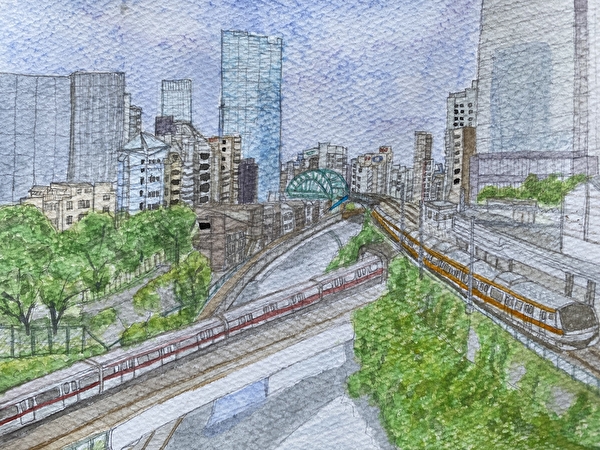「『檸檬』と『無縁坂』」
Do you know about Japanese songs? “Lemon” and “Muenzaka” are songs by Masashi Sada, a musician who represents the era from the Showa era to the present day. At 4T-AMKY, Teachers and Students write about Japanese culture, food, history, many spots to visit, and other stuff. Enjoy reading and knowing about deeper Japanese culture!
“Lemon” and “Muenzaka”
The scene that triggered my memory of the song
After a long time, I took a walk around Ochanomizu and approached the Hijiribashi Bridge. And the moment I saw this scene from the bridge, a melody ran through my mind. It is “Lemon” by Masashi Sada, a song that became a big hit when it was released in 1978.
In the song, there is a lyric that says, “The red color of the passing rapid train crosses the half-eaten lemon that she threw from the Hijiribashi bridge.” Because of my urge to actually view the scene and experience the world of Masashi Sada’s poetry, I visited this place with my friends when I was a student. I did not actually throw a lemon, but every time trains came by, I tried to imagine the lemon and train passing each other, as if I had thrown it. Such are my memories from more than 40 years ago.
The rapid train in this location was the Chuo Line, whose entire body was vermilion (orange) at that time. Now, train bodies are silver in color and marked with vermilion lines. Even with just this difference alone, I deeply felt the passage of time.
Then, four or five years ago, I took a walk from Shinobazu Pond in Ueno toward Yushima and approached a slope. The moment I saw the scene of the slope with the sign “Muenzaka,” a melody ran through my mind. It is “Muenzaka” by the Grape, a song from 1975, sung by Masashi Sada.

As I climbed the slope looking at the sign, lyrics about a son’s feelings for his elderly mother kept running through my mind, and I was filled with a sense of deep emotion.
On both occasions, the song played over and over in my mind for the next few days, bringing back various memories of when the song was popular and then disappearing. I spent a while indulging in the memories. I am sure that some of you may empathize with the scenes I have described.
I think everyone has one or two such memorable songs in their hearts. The power of music is great. This is a very subjective story, but the scenes of the city of Tokyo triggered songs that came back to mind. I introduced them along with the scenes as a part of Japanese culture of the Showa era.
「『檸檬』と『無縁坂』」
曲の記憶を呼び覚ます引き金となった風景
久しぶりに、御茶ノ水あたりを散歩して聖橋に差し掛かりました。そして、橋の上から見えるこの風景を目にした瞬間に、メロディーが頭の中を駆け巡りました。さだまさしさんの『檸檬』、1978年に発売され大ヒットした曲です。
曲の中に「食べかけの檸檬聖橋から放る 快速電車の赤い色がそれとすれ違う」という歌詞があります。その光景を実際に眺めて、さだまさしさんの詩の世界を味わってみたいという衝動に駆られて、学生時代に友人と一緒にこの場所を訪れたものです。実際に檸檬を放ることはしませんでしたが、電車が来るたびに、檸檬を放ったつもりで、すれ違う様子をイメージしてみた、という40年以上も前の思い出です。
この場所で、快速電車と言ったら中央線で、当時は車体全部が朱色(オレンジ)でした。今は車体の色は銀色で朱色の帯が目印になっています。その違いだけでも時代の流れをしみじみ感じます。
そして4,5年前、上野の不忍池から湯島方面へと散歩して坂道に差し掛かりました。「無縁坂」の看板が立っている坂道の風景が目に入った瞬間に、メロディーが頭の中を駆け巡りました。グレープの『無縁坂』、1975年の曲で、さだまさしさんの歌です。
看板を眺めて坂道を登りながら、年老いた母親への息子の思いを綴った歌詞がずっと頭の中を駆け巡り、しみじみした気持ちになりました。
どちらの時も、それから数日、頭の中で何度も何度も曲が流れ、その曲が流行っていた頃の様々な思い出がよみがえっては消えていきました。しばらく思い出に耽る日々を過ごしてしまいました。ご紹介した風景を見て共感してくださる方もいらっしゃるのではないでしょうか。
そんな思い出の曲は、誰の心にも一つや二つはあるものだと思います。音楽の力は偉大です。大変主観的な話ですが、東京の街の風景が引き金となって、曲が心によみがえってきました。それらの曲を昭和の日本文化の一つとして、風景と共にご紹介しました。
Ikuyo.K.






